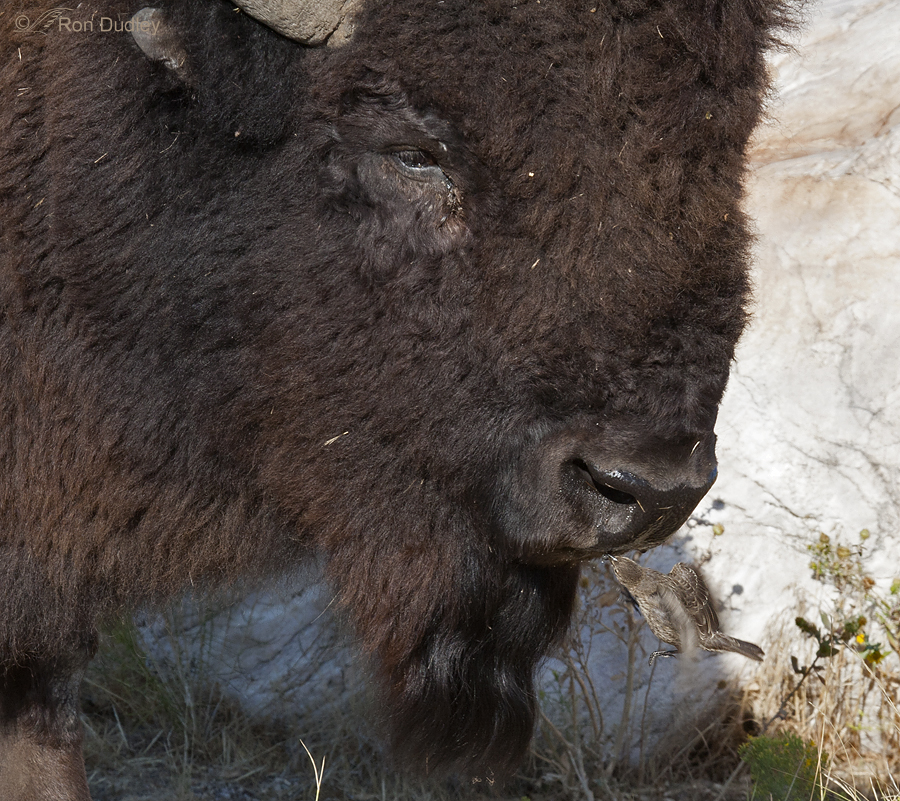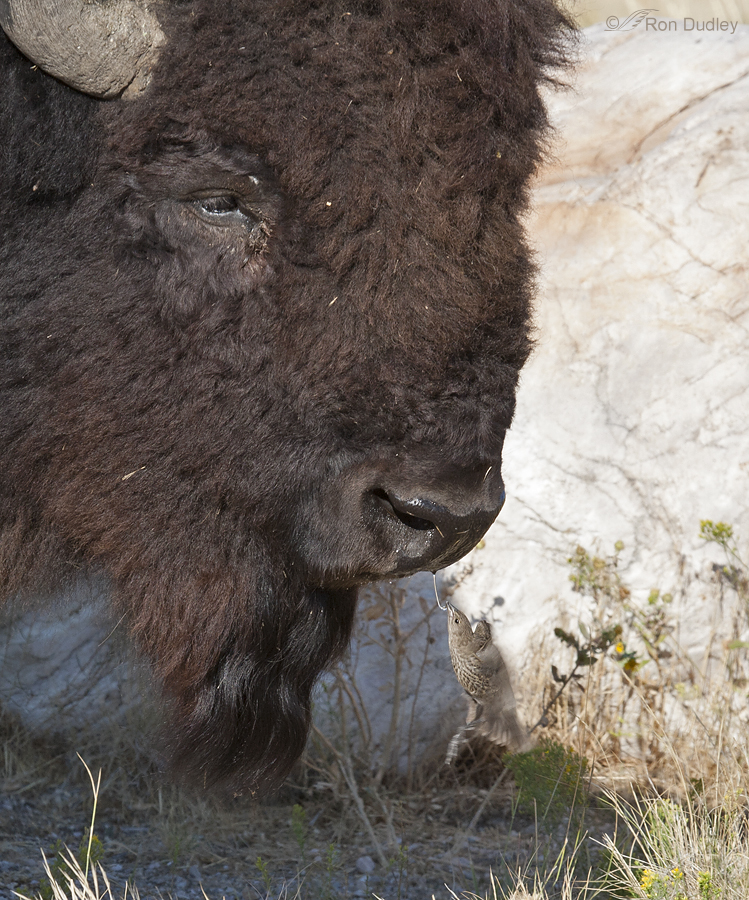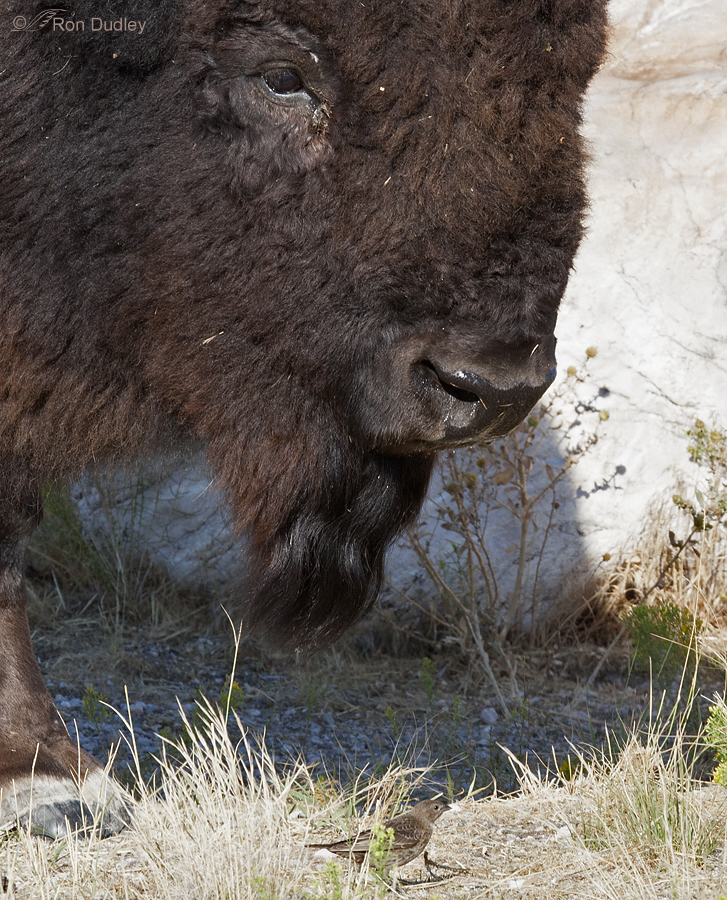Occasionally I rerun a favorite older blog post because few current readers have ever seen it. This one was published back on February 27, 2013. I’ve rewritten some of the text and tweaked the formatting. Image quality is mediocre because the photos were taken in very harsh light so I had to heavily process them in order to manage the extreme contrast as best I could and that produced some processing artifacts
For any who may be disturbed by the crassness of my title you have my permission to substitute mucus and saliva for the offending two words… 
Before Europeans came to North America and cleared forests which modified the environment into the agricultural and suburban landscapes of today the range of the Brown-headed Cowbird was limited to the short-grass plains where they followed the almost endless herds of American Bison and fed on the insects stirred up by those wandering behemoths. Early settlers so strongly associated cowbirds with bison that they almost exclusively called them “buffalo birds”.
Today that relationship continues to exist wherever bison can still be found and Antelope Island is one of those places.
One of the many challenges facing cowbirds was obtaining enough moisture as they followed the bison herds over the hot, rolling plains. Several years ago in late summer I photographed a cowbird behavior that illustrated one of their methods of dealing with that problem.
I found this huge bull languishing in the broiling sun next to a boulder that he had been using as a scratching post. A group of Brown-headed Cowbirds was in the vicinity but at first I wasn’t paying much attention to them. Then this female (at frame bottom) flew in very close…

and began flying at the nostrils of the bull. Initially I was unsure about what she was doing but she did it repeatedly and eventually it became clear that she was…

drinking the mucus-laden secretions from the bison’s nostrils and/or mouth. She would actually hover in place as she gobbled down the long, stringy strands of mucus.
Not a pretty sight and perhaps a bit unsettling to delicate sensibilities but what an incredibly adaptive behavior for survival in hot, arid conditions.
I love seeing and documenting stuff like this!
Ron



It made me smile, picking one’s nose is one matter, but picking someone else’s nose is something else!
Arguably gross, but unquestionably efficient. And reminds me (again) how grateful I am for running tap water.
Me too…
Well done, Ron! I guess desperate times call for desperate measures!
Exactly, Diane.
Mmmmmm…boogers! I’m hoping I can use these images once I get back to the classroom. I’m just picturing the looks on my students’ faces! Priceless!
Yup, student’s tend to have rather interesting reactions to behaviors like this, Marty.
HEHEHE!! Sometimes you have to meet them at their level
I delight in your behavioral stories/images! Who’da thunk this one! But when times are tough, you do what you gotta do to survive and thrive, and as long as cowbirds aren’t leaving their kids around, I’m good with them. But that leaving their kids for others to raise is just NOT a good thing!
I’m good with the snot and spit in your story, however, a cold managed to catch me and the whole snot thing is a PITA at the moment! I’ve been prodigiously producing snot for a couple of days now, so I’ve got plenty to spare. Where does that stuff come from for pity’s sake? Jeesh! Not sure I’d welcome a cowbird, though
“Not sure I’d welcome a cowbird, though”
Now THAT part of your comment brought an image to mind, Laura! Thank you.
Falconers aren’t that civilized. You begin to mirror your bird(s)’s personality after just a little bit. But I really draw the line at some things…not many, but there is a line
I hear you on the inexaustible supplies of snot. I am sure I remember being taught that matter is neither created nor destroyed. So where does it come from? And why aren’t I several stones light after a heavy cold? And isn’t a heavy cold a salutory reminder that tissues are made of wood?
Get better (and drier) soon.
Love your replies EC…just so you know!
Thank you. I learn from Ron and I learn from you and so many others who comment here. For which I am very grateful.
And I learn from you. That’s the joy of this blog…we can all get our learn-something-new-every-day thing polished off in the morning, we’re free to let even more information roll on in. When we can do it with humor along the way, so much the better! As Mia says every morning, “Life IS good!” And I treasure the opportunity to read your words every day.
Wow, so interesting!
Ultimately, NOTHING GOES TO WASTE in the web of life in which we live……..I’m glad that you posted this again, as I hadn’t seen it before. I’m glad to know that even “snot and spit” can support
another creature’s livelihood !
“I’m glad that you posted this again”
Good. I figured that most current readers had never seen it.
Fascinating! That last picture provoked an involuntary “Eewwww,” but the concept doesn’t bother me. Don’t get me started on starlings, though!
Thanks, Kris. Yes, starlings are a huge problem.
Wonderful behavioral shots Ron, many thanks!
Certainly an appropriate adaptation and survival trait for the Cowbird. What is interesting to me is that one can’t think of most natural situations in nature where there isn’t some form of adaptation to allow an organism to survive in conjunction with another, mutualism, commensalism, or parasitism comes to mind.
Behavioral shots ROCK!!!
“Behavioral shots ROCK”
We definitely share our soft spots for behaviors, Dick. Thank you.
Always interesting. Thanks for taking the time to reply to all of these comments.
Thanks, Robert.
I think the concept of this would bother me anyway, but before breakfast… It was a little too much. And yet the concept is not unfamiliar. I’ve seen butterflies going after moisture from scat and from a dead frog. I still get riled up over Cowbirds because their parasitism really bothers me, and unfortunately always comes to mind whenever I see or read about them. But the adaptation for getting moisture is very interesting.
Yeah, my coffee tasted a little strange this morning while I was writing this post, Susan…
Personally I’ve never had a problem with the parasitism of cowbirds. I’m not so forgiving of the problems with starlings though…
Repulsive but fascinating! ….nature’s ability to adapt continually amazes me. I never knew this. In the time I’ve followed your blog, whatever it’s been, I’ve learned something new every, single day!!!!
Delighted to hear that, Patty. Blogging is a huge learning experience for me too.
FYI, I just did a little research on your commenting history. You’ve commented 3088 times since 1/27/13. Your first comment was on this post:
https://www.featheredphotography.com/blog/2013/01/27/a-guide-to-aging-bald-eagles/
Thanks for all your support over the years!
Where there is the will, there is a way!! Gross, but very educational. Thanks for sharing.
Thanks, Barbara.
Huh! Amazing how critters will adapt to survive………….. Your terms perfectly describe the situation even if what the cow bird is doing is a bit gross! Of course, “where I come from”…….:)
Of course, “where I come from”…….:)
Agreed, Judy. I think it’s a very interesting and even admirable survival strategy.
Great photos. Considering where I work the mucus thing kind of got to me. I guess it’s the thought of eating it. Blah.
April, Seems to me the “where you work” part could potentially apply to either or both the classroom or your rehab work. So you get a second chance at it!
Very interesting, Ron. I enjoy your blog not only for the photography, but for your observations of nature. I realize it’s the artist behind the camera, not the lens in front of it that creates great photography. But my wife and I recently acquired your lens of choice, the Canon 500mm f/4L. And this decision was influenced largely from seeing what you’re able to do with it. Thank you for your daily posts. It’s definitely a great start to my day!
Huge congratulations on your new lens purchase, David! That’s a big step both photographically and financially but IMO you couldn’t have made a better choice. There’s a significant learning curve involved in becoming proficient with it but what an adventure awaits you and your wife!
Wow! I have never seen anything like that! Thank you for sharing it.
Mary, I have vague memories from when I was a kid on the farm and seeing birds do similar things with cattle. Wouldn’t swear to it though…
An amazingly candid and resourceful bird! Is this an innate or a learned adaptation among Cowbirds? Does the Bison’s indifference or compliance/association play a role in the adaptive behavior or is it entirely one sided and opportunistic? I’m not sure I am wording that correctly.
Robert, I don’t know if it’s innate or learned – seems to me it could be either but my vote would be that it’s learned. Bison are certainly compliant in this situation (to extreme, it almost seemed unaware of the bird at its nose) but I doubt it’s a symbiotic relationship.
Thanks Ron. I don’t think nature is ever uncouth or disgusting, but if I were a Bison I just might raise dust over it.
I seldom see bison react to birds around or on them, Robert. Although recently I did see one big bull reach around with his head and chase a magpie off his back. Usually they ignore magpies too.